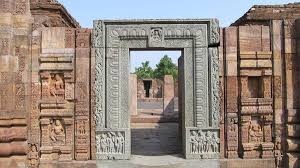Ratnagiri: Despite measures to attract tourists from South Asia and Southeast Asia to the Buddhist triangle, known as Diamond Triangle of Ratnagiri, Lalitgiri and Udayagiri, the ground reality evinces a different tale.
Ratnagiri hills under Bari block of Jajpur district can be taken as a case in point. Several tourists and locals have alleged that funds sanctioned for the development and security of this tourist spot go to the pockets of unscrupulous government officers.
Crores of rupees have been misappropriated by officials for over 10 years in the name of development, alleged locals.
Ratnagiri monastery, crowning flat hilltop with a panoramic view of the surrounding, is suitable for seclusion, serene and calm atmosphere needed for meditation.
Excavations made by the Archaeological Survey of India at the site between 1958 and 1961 unearthed seals bearing legends of Sri Ratnagiri Mahavihariya Aryabikshu Sanghasya. The walls of Ratnagiri stand testimony to Hieun Tsang’s visit to the monastery.
Excavations in the 1960s yielded the remains of an impressive Stupa (1) surrounded by a large number of votive stupas of varying dimensions, two quadrangular monasteries (1 and 2), a single-winged huge monastery with beautiful carved doorjamb and lintel, spacious open courtyard, cells and verandah facing the courtyard with spacious sanctum enshrining colossal Buddha. The existence of temple with curvilinear tower is only one-of-its-kind discovered in Odisha.
A number of stone sculptures, a few bronze and brass images of Buddha and Buddhist pantheon recovered during excavations tend to prove that Ratnagiri was a great Tantric centre of Buddhism comparable to that of Nalanda in Bihar.
A re-excavation was done by the department between 1997 and 1999. The relics recovered at that time are preserved in a museum situated atop the hill.
It may baffle many that there is no parking space and restroom (Yatri Niwas) for tourists to Ratnagiri.
“We had heard about the Buddhist site. We thought the government would have developed the site as it has been projected globally. After reaching the site, we found the tall claims of the state government falling flat,” said a visitor.
Apart from the parking difficulties, the site is also not protected properly as the boundary wall is crumbling. The gaps on the wall allow stray cattle to enter the heritage site.
Plants and shrubs, meant to beautify the site, have withered due to lack of care.
With no Yatri Niwas in the vicinity, outstation visitors cannot stay for more than a few hours, sources said.
Growing incidents of harassment of overseas visitors by anti-socials is another reason why they do not pay a second visit to the site.
Buddhist sculptures, museum, Mahakal temple and the sylvan surroundings attract tourists. But safety of the visitors and sculptures is the need of the hour, locals observed.
The state government has reportedly sanctioned Rs 8 crore for the development of the site. Orissa Post tried to reach out to the Archeological Survey of India officials but it yielded no result.
PNN
